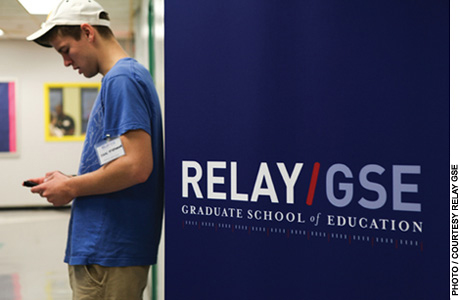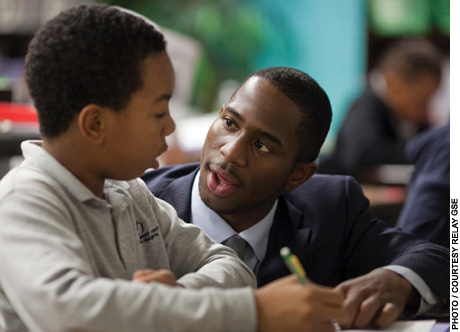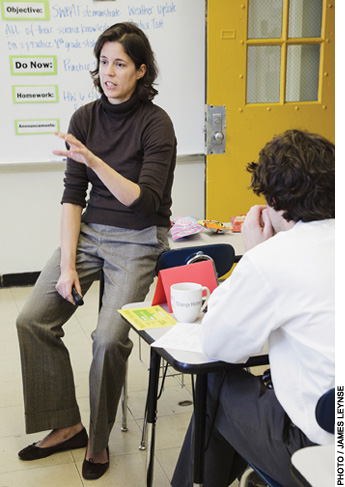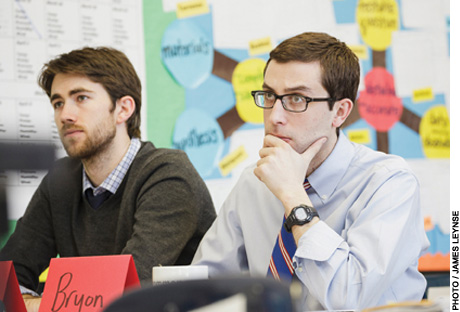 I was observing a class called Designing Assessments at the new Relay Graduate School of Education when a student asked if it was OK to rework questions from a teachers’ guide to fit the English lesson she was teaching in a Brooklyn middle school that week. Sure, said Mayme Hostetter, Relay’s dean: “No need to totally invent the wheel. Just make the wheel amazing.”
I was observing a class called Designing Assessments at the new Relay Graduate School of Education when a student asked if it was OK to rework questions from a teachers’ guide to fit the English lesson she was teaching in a Brooklyn middle school that week. Sure, said Mayme Hostetter, Relay’s dean: “No need to totally invent the wheel. Just make the wheel amazing.”
Hostetter might just as surely have been talking about Relay, which aims to transform teacher education to fit the needs of urban schools. The amazing—or at least attention-getting—improvement on the wheel is that New York–based Relay is linking the success of its students to the success of their students.
During their second year in Relay’s two-year masters-degree program, elementary-school teachers are asked to show that their own students averaged a full year’s reading growth during the school year. They must also set a reading goal for each child, perhaps two years’ growth for a child who is three years behind, for example. Students can earn credit toward an honors degree if 80 percent of the children they teach meet their individual reading goals.
To earn their degrees, elementary-school teachers are also asked to show that their students earned, on average, 70 percent mastery on a year’s worth of state or Common Core Standards in another subject, usually math. In other words, a math class would meet the goal if students’ individual mastery scores, when averaged, were 70 percent or better. Middle-school teachers use the same yardstick, but only in their specialized subject.
Relay’s cofounder and president, Norman Atkins, talks movingly about the crisis in inner-city teaching and the need to “grow a pipeline of effective teachers who can make an immediate difference.” But the true value of Relay’s model may go beyond potentially improving the teaching in the classrooms where Relay’s graduates work. Robert Pianta, dean of the University of Virginia’s Curry School of Education, explained that Relay is creating a “feedback loop,” using child-level data to measure the outcomes of its teacher-training program, and using those measures to make decisions about program design. “This is how systems get better,” he told me.
Spreading accountability from the teacher back to the education school is an idea the Obama administration is also promoting in its efforts to remake teacher training. This spring, a federal panel looking at teacher-preparation programs debated, among other things, rating ed schools based on how much their teachers add to student learning. That possibility riles ed school deans, among others, but “individual accountability is coming down the pike,” says Kate Walsh, president of the National Council on Teacher Quality, a research and advocacy group.
Even Relay’s admirers concede that it’s too soon to tell whether the model works. It’s operating in just two cities: New York, where it’s offering a master’s degree to 206 students this year, and Newark, New Jersey, where so far it has state approval only to offer a one-year teaching certificate and has enrolled 64. Relay’s first class won’t graduate until 2013. Philanthropies are still footing much of the bill.
Relay has hired a research director, but Atkins says it may not open itself to independent researchers for another four years. Its students—with undergraduate degrees from the likes of the University of Virginia, Lafayette, and Georgetown—are atypical for an ed school, which could complicate comparisons with other teacher programs. Above all, trying to measure student achievement and a teacher’s role in improving it is hard to do.
Still, says Arthur Levine, former president of Columbia University’s Teachers College and a member of Relay’s board, Relay is helping to reinvent teacher education. “Relay is the model,” he told me. “It is the future.”
Nuts and Bolts

If there were ever a system in need of reinvention, it would be teacher education. Decades of studies, reports, and blue-ribbon commissions have criticized ed schools for low entrance requirements, mediocre standards, an emphasis on theory over practice, and outdated curricula. “It’s an accepted truth that the field is broken,” Walsh told me. The problem with fixing it, she added, is that “nobody has known what to do.”
What Relay is doing largely breaks the mold. Its students are full-time elementary- and middle-school teachers, almost all of them fresh out of college, almost none of them with a traditional teaching degree. The program is heavy on practice and nuts-and-bolts technique. It is competency-based: students can be waived out of Designing Assessments, for example, if they can show they are already adept at writing tests.
Relay’s method flips the classroom, with an online lesson at the start of every module or teaching unit (about 40 percent of instruction is online) and in-class discussions and exercises afterward. Twice-monthly night classes, once-monthly Saturday classes, and two summer terms are taught by master teachers and charter school heavyweights. Online instructors include Lee Canter, author of Assertive Discipline, charter school founders and principals, and Relay professors and deans.
Modules vary in duration and range from the nitty-gritty of classroom management—how to arrange furniture, how to grade papers, how to deal with families, how to open and close a lesson—to big-picture subjects, including literacy instruction, writing development, learning disabilities, unit planning, and character development. For a class called Benchmarking and Tracking Progress, scheduled to last 11¼ hours, the catalog says Relay students will create a spreadsheet to track their own students’ progress against year-end goals, and use the data to customize their teaching. In a class called Behavior Management Plans, Relay students will write a set of classroom rules and learn “how to engage in the very necessary practice of correcting students when they misbehave.”
Everybody Engaged
I logged onto an online lesson for a module titled Engaging Everybody, taught by Doug Lemov, managing director of Uncommon Schools. In the 3¾-hour lesson, Lemov lectured for three or four minutes on each of four techniques that he promotes to keep youngsters involved in class, techniques he labels “wait time,” “everybody writes,” “cold call,” and “call and response.” Each of Lemov’s minilectures was followed by a few pages of online reading from his book Teach Like a Champion, and an essay question or two that students answer online (see “Tools for Teachers,” book reviews, Spring 2011). Then came several short videos showing teachers using each technique in the classroom, with Lemov noting the teachers’ use of an apt pause or effective gesture.
Ed schools typically separate lectures from experience, Arthur Levine pointed out to me; by putting lessons online, Relay can blend them. Next came practice scenarios—what do you do if only three children raise their hands to a question about angles?—online group exercises, and instructions to prepare a lesson plan that incorporates the techniques.
Evening classes are on pedagogy—how to teach—and Saturday classes are on subject matter—what to teach. At the second Engaging Everybody evening class, Relay students are expected to present a 10-minute video of themselves using the techniques in their own classrooms. A complex “rubric” describes how students will be assessed on each: on the wait-time technique, students are evaluated on whether they wait at least three seconds between posing a question and calling on a child for an answer, and whether they “strategically narrate” the wait with encouraging comments.
The classroom lessons are heavily scripted. During the first three minutes of the Engaging Everybody class, for example, the Relay students are to report on how often they’re using the four techniques. The script then lists four paragraphs of narrative and questions for the Relay professor to pose over the next four minutes. For five minutes after that, there’s a review, with 10 questions for the professor to ask, and then a suggested transition: “All right, our minds are fresh on today’s content and we’re ready to move.” Then there’s a guided 7-minute “table discussion,” 5 minutes of class discussion, 11 minutes of partner feedback, and so on.
“It is the most self-consciously designed program I’ve ever seen at a university level. Everything was thought out,” said David Steiner, dean of the Hunter College School of Education, which hosted Relay’s predecessor, Teacher U, beginning in 2008. (Teacher U’s last class of about 147 students will graduate this summer.)
Relay students “model” the kind of behavior they hope to see in their own classrooms, so their hands fly up at questions, they rush to stack chairs and pass out papers, they snap their fingers or waggle their hands to show approval. Relay’s scripts do the same kind of modeling by showing students how to effectively use their limited class time, Steiner explained.
Feedback Loop

Relay’s class of first-year students had moved to the 6¾-hour Designing Assessments module when I visited in the spring. At the first of the module’s two evening classes, they had practiced writing “exit tickets,” quick quizzes to measure kids’ understanding of that day’s lesson. At the second evening class, students were to write an end-of-the-week test. Again, the script divided the evening into increments, with 45 minutes for students to practice writing test questions and the final 10 minutes for “team building.”
The Newark class, held at North Star Academy Charter School, was looser than the script suggested—and heavier on inspiration. James Verrilli, director of the Newark program and founding principal of North Star, opened with a clip from a Hollywood film about an innocent man’s decades-in-the-making escape from prison, and asked how it related to urban teaching.
The communal answer was that the escape seemed doomed—“like some people look at our kids,” one young woman said—but that perseverance and vision will yield success. “Shout-outs” followed that, with Verrilli singling out students, and students singling out each other, for exemplary work in their classrooms that week. The evening closed with an animated call-and-response reading of Relay’s creed, which ends with the lines, “We touch lives daily. We are teachers.”
In between, the discussion ranged from how to align test questions with the state standards to the layout of a test paper. There was agreement that some questions on the New Jersey tests included extraneous information that obscured the lesson. But “if the state is doing it, we don’t want our kids walking in blind,” said another young woman, who suggested that everyone write a few wordy questions for their own students to practice.
A few days earlier, I attended a Saturday class at Baruch College Campus High School. It gathered most of the Relay students working in New York City schools (mostly in charters, but a few in district schools where Teach For America has assigned them), divided them into subject specialties, and then again by elementary- and middle-school levels. Relay says 61 percent of the New York class is working toward a master’s degree in childhood education, 9 percent in middle-school math education, 5 percent in middle-school science, 3 percent in social studies, 12 percent in English, and 10 percent in general middle-school education.
In a class called Geometry, Fractions, and Measurements, Nicole Chalfoun—a former Bronx 5th-grade teacher—asked Relay students to design a “remediation strategy” for a child whose answer to the equation 2/5 + 3/8 is 5/13. “Where would you start?” she asked, as her students discussed which manipulatives would best convey to the child why uncommon denominators can’t be combined.
In Teaching Middle School Social Studies III, Ali Brown—director of history achievement for the Achievement First schools—asked her class to write an “essential question” that would frame a unit they were soon to teach on the American Revolution. “What is best going to make your kids think hard?” she asked. In an Elementary School Literacy class—the last of 10 sessions in the module—students were critiquing videos they had made of themselves teaching a reading lesson. In Teaching Middle School Math III, the morning began with a game called Buzz and a discussion of ways to modify it to include higher-level math, including calculus.
Every class meeting ends with a survey—was the lesson helpful, how could it be improved?—with comments fed back to course designers, says Hostetter.
The students I talked with—almost all of them first-year teachers—told me that Relay’s lessons were helping them plan their classes, practice their presentations, keep their kids engaged. “Everything I learn here I can use the next day,” said Milan Reed, who graduated from the University of Virginia with a major in political and social thought and now is teaching at Newark’s Spark Academy charter school.
“I get ideas, I get practice, I get feedback,” added Adam Feiler, a 2008 Georgetown graduate and Teach For America volunteer who’s teaching 4th grade at North Star’s Vailsburg Campus elementary.
Many also told me that Relay’s lessons have changed their classroom culture. “The culture went from being compliant to being invested,” said Max Silverstein, a Penn State business major now teaching in an early-childhood classroom at Newark Legacy Charter School. I heard the same thing from Alonte Johnson, a Morehouse College English major who is teaching middle-school English at Kings Collegiate Charter School in Brooklyn. A few days earlier, his students designed a seating chart that paired the better and slower readers. “The environment is more interdependent instead of everyone working for me,” he said.
On a Mission

Norman Atkins, who founded Uncommon Schools and its North Star Academy as well, said he, David Levin, cofounder of the KIPP charter schools, and Dacia Toll, founder of Achievement First schools, began talking about an education school when they found themselves competing for the same teachers. “Rather than fight over a shallow pool of talent, we were interested in what it would take to build a generation of teachers,” he told me in Relay’s spare Manhattan offices above a public library. (Levin and Toll are on the Relay board, but don’t hold executive positions in the nonprofit.)
They approached 10 college presidents looking for a partner institution, Atkins said, and Hunter’s David Steiner, himself a critic of teacher training, “was waiting for us with open arms.” Last year, seeking more autonomy, Atkins launched Relay and began phasing out Teacher U. The new school takes its name from research suggesting that a “relay” of three years of good teachers can erase the average educational disadvantage of low-income children.
The idea of holding Relay students—and before them, students at Teacher U—accountable for their students’ progress was “one of the very first things we talked about,” Atkins said. The school settled on the 70 percent average mastery floor after looking at the New York math and language tests, where proficiency generally is defined as a score of 70 percent correct answers. The 80 percent stretch goal (for the honors degree) was less data-based but is “at the nexus of ambition and feasibility,” said Brent Maddin, Relay’s provost.
Some 95 percent of Teacher U’s 2010 graduates and 98 percent of its 2011 graduates met the 70 percent targets, he said, although the graduation rate over the two-year master’s program is lower, between 70 percent and 80 percent because of attrition, Hostetter noted.
Reading progress can be assessed with any of six tests, including Fountas and Pinnell Benchmarks and Pearson’s DRA2. But subject tests don’t exist for all subjects and grades. Relay’s handbook says its students instead can use tests they acquire elsewhere or even write themselves, if the assessments show mastery of state or Common Core standards, or of standards set by charter networks or individual schools.
I asked Verrilli, head of the Newark program, how Relay could analyze achievement among youngsters taking so many different tests (a half dozen of his Newark students who are teachers in district schools are writing their own year-end assessments). It wasn’t an apples-and-oranges comparison, he said, but one between “McIntosh and Golden Delicious.” The comparison isn’t among tests, but about mastery levels, he said.
I put that to Scott Marion, associate director of the National Center for the Improvement of Educational Assessment, who told me that Relay was “dreaming” if it hoped to compare performance across schools, but he otherwise sounded supportive. “I care about the end determination: Is the teacher effective or not,” Marion said, “not ‘did these kids achieve a number’?”
Atkins is a serial social entrepreneur who also started the Robin Hood Foundation, which invests in schools and antipoverty programs in New York. His plans for Relay set a breakneck pace: Next year, he expects Relay to enroll 500 to 550 students in New York and New Jersey. It will add classes for high school teachers, including chemistry, biology, and physics. It has applied to New Jersey to begin a master’s program. And Relay expects to extend its reach further into district schools under an agreement to train up to 60 NYC Teaching Fellows in the Bronx.
Atkins said he expects Relay to be fully supported by tuition and client-school fees in three or four years. For now, philanthropies are footing about $13,000 of the $35,000 two-year tuition bill. Students pay about $4,500, with charter schools and federal grants and subsidies making up the rest. Arthur Levine, the board member, agrees with Atkins’s aim. “For innovation to survive, it has to be self-sustaining. If something’s not self-sustaining, it’s not serious,” he told me. And Relay is nothing if not serious.
“What calls us every day is the sad and tragic circumstance” of urban education, Atkins told me, and in one phrase or another, everyone at Relay says the same thing. The other thing they all told me turns on its head the notion of what makes a great teacher.
“We’re saying great teachers are made,” James Verrilli told me, “not born.”
June Kronholz is a contributing editor of Education Next and a former foreign correspondent, bureau chief, and education reporter for the Wall Street Journal.
This article appeared in the Fall 2012 issue of Education Next. Suggested citation format:
Kronholz, J. (2012). A New Type of Ed School: Linking candidate success to student success. Education Next, 12(4), 42-48.


